英国历史英文版
英国伦敦的历史作文英文
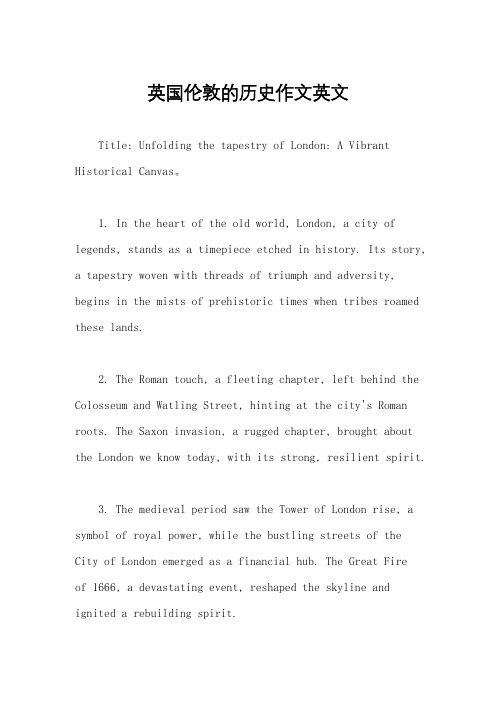
英国伦敦的历史作文英文Title: Unfolding the tapestry of London: A Vibrant Historical Canvas。
1. In the heart of the old world, London, a city of legends, stands as a timepiece etched in history. Its story, a tapestry woven with threads of triumph and adversity, begins in the mists of prehistoric times when tribes roamed these lands.2. The Roman touch, a fleeting chapter, left behind the Colosseum and Watling Street, hinting at the city's Roman roots. The Saxon invasion, a rugged chapter, brought about the London we know today, with its strong, resilient spirit.3. The medieval period saw the Tower of London rise, a symbol of royal power, while the bustling streets of theCity of London emerged as a financial hub. The Great Fireof 1666, a devastating event, reshaped the skyline and ignited a rebuilding spirit.4. The Industrial Revolution, a technological revolution, gave birth to the modern London, with itsiconic Tower Bridge and the Thames River, a lifeblood of trade and commerce. The 20th century saw the city transform into a cultural melting pot, with the West End's theaters echoing the laughter of the West.5. The present day, a city of contrasts, blends the old with the new. London Eye soars above the city, offering panoramic views, while the city's diverse population adds a vibrant layer to its cultural tapestry.6. London, a city that never sleeps, is a living testament to its enduring legacy. Its history, like aliving museum, is a testament to the resilience and adaptability of its people, forever evolving and preserving its past.7. In the end, London's history is not just a record of events, but a living, breathing narrative, a story that continues to unfold, waiting to be discovered by eachvisitor and resident who steps into its bustling streets.Remember, this is a snapshot, a snapshot of a city that timelessly weaves its tale, a city that is always, simply, ChatGPT.。
英国文化介绍(英文版ppt)
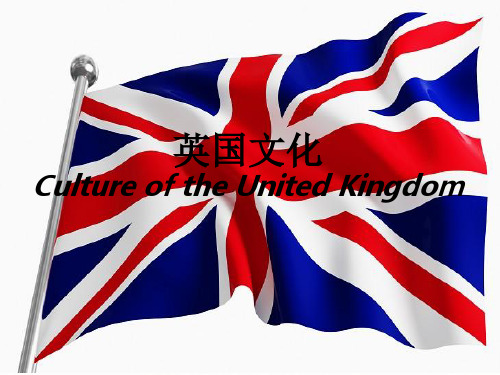
英国茶文化 Tea Culture 英国茶文化
Accounts of its origins vary. Drinking a blend of black teas for breakfast is indeed a longstanding British custom.The practice of referring to such a blend as “English breakfast tea”appears to have originated nor in England but America, as far as Colonial times.
维多利亚女王
维多利亚是第一个以“大不 列颠和爱尔兰联合王国女 王和印度女皇”名号称呼的 英国君主
英国节日——圣·帕特里克节
圣帕特里克节(St. Patrick‘s Day)是每年 的3月17日,是为了纪念爱尔兰守护神圣帕 特里克。这一节日5世纪末期起源于爱尔兰。 人们大多按照传统习俗穿着黄色和绿色的 衣服,脸上也用绿色油彩描画出三叶苜蓿 的图样。传说中,圣帕特里克当年在爱尔 兰传教时,就是利用三叶苜蓿向人们讲述 基督教义的。燃放焰火也是庆祝圣帕特里 克节不可缺少的一个组成部分。当夜幕降 临,美丽的焰火在天穹划出一道道绚烂迷 人色彩,人们欢呼雀跃,相互送去温馨的 祝福。虽说圣帕特里克节是爱尔兰的传统 节日,但数百年来,随着爱尔兰后裔遍布 欧美各国,这一节日也渐渐成为西方国家 共同的节日。
伊丽莎白塔(英语:Elizabeth Tower,旧 称大本钟,BIG BEN),即威斯敏斯特宫 钟塔,世界上著名的哥特式建筑之一,英国 国会会议厅附属的钟楼(Clock Tower) 的大报时钟的昵称。是坐落在英国伦敦泰晤 士河畔的一座钟楼,是伦敦的标志性建筑之 一。钟楼高95米,钟直径9英尺,重13.5吨。 每15分钟响一次,敲响威斯敏斯特钟声。 自从兴建地铁Jubilee线之后,大本钟受到 影响,测量显示大本钟朝西北方向倾斜约半 米。 伊丽莎白塔于1858年4月10日建成,是 英国最大的钟。塔有320英尺高(约合97.5 米),分针有14英尺长 (约合4.27米), 大本钟用人工发条,国会开会期间,钟面会 发出光芒,每隔一小时报时一次。每年的夏 季与冬天时间转换时会把钟停止,进行零件 的修补、交 换,钟的调音等。
英国部分历史事件的英文解释
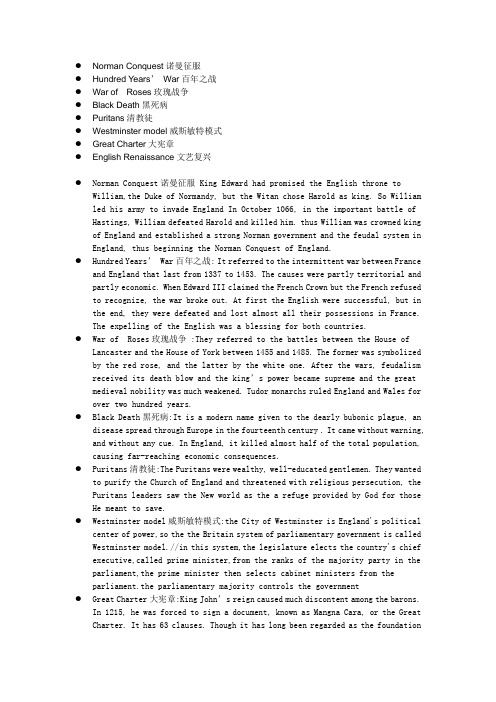
●Norman Conquest诺曼征服●Hundred Years’War百年之战●War of Roses玫瑰战争●Black Death黑死病●Puritans清教徒●Westminster model威斯敏特模式●Great Charter大宪章●English Renaissance文艺复兴●Norman Conquest诺曼征服 King Edward had promised the English throne toWilliam,the Duke of Normandy, but the Witan chose Harold as king. So William led his army to invade England In October 1066, in the important battle of Hastings, William defeated Harold and killed him. thus William was crowned king of England and established a strong Norman government and the feudal system in England, thus beginning the Norman Conquest of England.●Hundred Years’ War百年之战: It referred to the intermittent war between Franceand England that last from 1337 to 1453. The causes were partly territorial and partly economic. When Edward III claimed the French Crown but the French refused to recognize, the war broke out. At first the English were successful, but in the end, they were defeated and lost almost all their possessions in France.The expelling of the English was a blessing for both countries.●War of Roses玫瑰战争 :They referred to the battles between the House ofLancaster and the House of York between 1455 and 1485. The former was symbolized by the red rose, and the latter by the white one. After the wars, feudalism received its death blow and the king’s power became supreme and the great medieval nobility was much weakened. Tudor monarchs ruled England and Wales for over two hundred years.●Black Death黑死病:It is a modern name given to the dearly bubonic plague, andisease spread through Europe in the fourteenth century . It came without warning, and without any cue. In England, it killed almost half of the total population, causing far-reaching economic consequences.●Puritans清教徒:The Puritans were wealthy, well-educated gentlemen. They wantedto purify the Church of England and threatened with religious persecution, the Puritans leaders saw the New world as the a refuge provided by God for those He meant to save.●Westminster model威斯敏特模式:the City of Westminster is England's politicalcenter of power,so the the Britain system of parliamentary government is called Westminster model.//in this system,the legislature elects the country's chief executive,called prime minister,from the ranks of the majority party in the parliament,the prime minister then selects cabinet ministers from theparliament.the parliamentary majority controls the government●Great Charter大宪章:King John’s reign caused much discontent among the barons.In 1215, he was forced to sign a document, known as Mangna Cara, or the Great Charter. It has 63 clauses. Though it has long been regarded as the foundationof English liberties, its spirit was the limitation of the king’s powers, keeping them within the bounds of the feudal law of the land.English Renaissance文艺复兴: Renaissance was the revival of classical literature and artistic styles in European history. It began in Italy in the early 14th century and spread to England in the late 15th century.The English Renaissance had 5 characteristics: (1) English culture was revitalized not so much directly by the classics than other European countries; (2) England followed a course of social and political history which was large independent on European history; (3) Owning to the great genius of the 14th century poet Chaucer, the native literature was vigorous enough and experienced foreign influences without being subjected by them; (4) English Renaissance literature is chiefly in artistic, rather than in philosophy and academy; (5) theRenaissance coincided with the Reformation in England. Its finest exponents were Christopher Marlowe, Ben Jonson, and William Shakespeare. (1)英国文化的复兴,不全是直接受古典文化的影响,而更多的是受当时有文艺复兴思想的欧洲人的影响;(2)作为岛国,英国的社会和政治历史进程在很大程度上独立于欧洲其他国的历史进程;(3)由于14世纪产生了伟大天才诗人乔叟,英国本土文学相当有生气,善于融合外来影响而未被同化;(4)英国文艺复兴时的文学主要是艺术的,而非哲学及学术的;(5)文艺复兴与英国宗教改革同时发生。
英国历史故事英文版
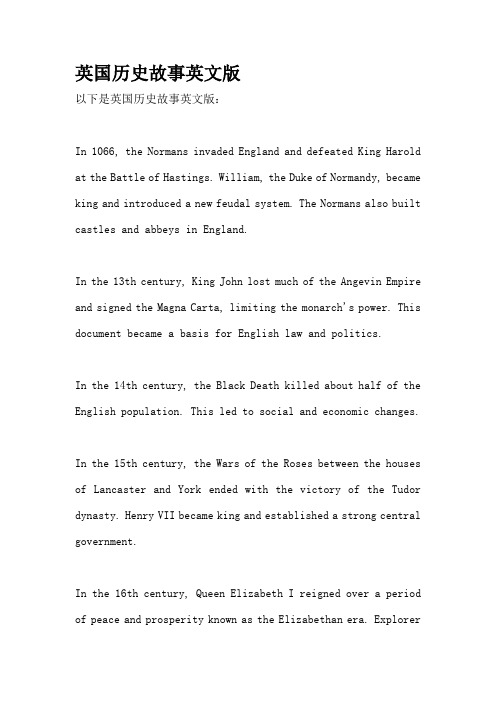
英国历史故事英文版以下是英国历史故事英文版:In 1066, the Normans invaded England and defeated King Harold at the Battle of Hastings. William, the Duke of Normandy, became king and introduced a new feudal system. The Normans also built castles and abbeys in England.In the 13th century, King John lost much of the Angevin Empire and signed the Magna Carta, limiting the monarch's power. This document became a basis for English law and politics.In the 14th century, the Black Death killed about half of the English population. This led to social and economic changes.In the 15th century, the Wars of the Roses between the houses of Lancaster and York ended with the victory of the Tudor dynasty. Henry VII became king and established a strong central government.In the 16th century, Queen Elizabeth I reigned over a period of peace and prosperity known as the Elizabethan era. ExplorerFrancis Drake circumnavigated the world in the Golden Hind.In the 17th century, King James I succeeded Elizabeth and established the Stuart dynasty. The English Civil War broke out in 1642 and ended with the execution of King Charles I in 1649. The monarchy was then abolished and replaced by a republican government known as the Commonwealth of England.希望这个故事能满足您的需求。
《英国历史英文版》课件
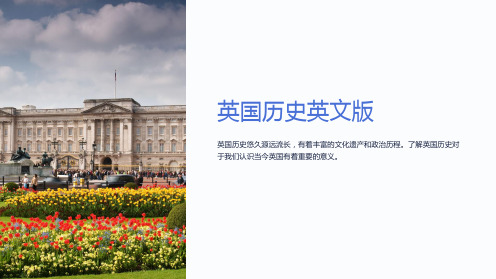
World War II saw Britain stand
economic changes in the
alone against Nazi Germany, and
subsequent years.
the country's bravery in the face of
the Blitz remains an enduring
Stuart Era
James I and the Gunpowder Plot
King James I faced numerous challenges during his reign, including the infamous Gunpowder Plot in 1605.
Charles I and the English Civil War
Innovation and technological advancements led to a seismic shift in the way goods and services were produced, transforming the British economy and society adernize the country.
The decision to leave the European
Union in 2016 has plunged Britain
into years of uncertainty and
debate, as the country grapples
Victorian Era
Queen Victoria and the British Empire
Queen Victoria's reign marked the height of British power and influence, as the country enjoyed unprecedented prosperity and global supremacy.
英国历史中的奥法传奇英文版
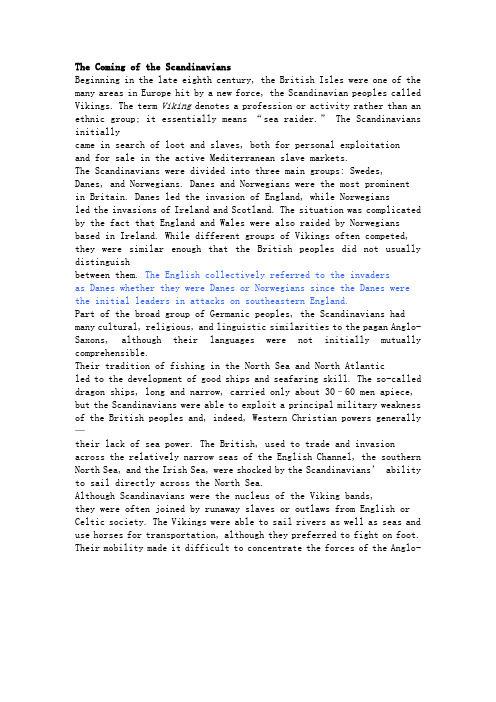
The Coming of the ScandinaviansBeginning in the late eighth century, the British Isles were one of the many areas in Europe hit by a new force, the Scandinavian peoples called Vikings. The term Viking denotes a profession or activity rather than an ethnic group; it essentially means “sea raider.” The Scandinavians initiallycame in search of loot and slaves, both for personal exploitationand for sale in the active Mediterranean slave markets.The Scandinavians were divided into three main groups: Swedes, Danes, and Norwegians. Danes and Norwegians were the most prominentin Britain. Danes led the invasion of England, while Norwegiansled the invasions of Ireland and Scotland. The situation was complicated by the fact that England and Wales were also raided by Norwegians based in Ireland. While different groups of Vikings often competed, they were similar enough that the British peoples did not usually distinguishbetween them. The English collectively referred to the invadersas Danes whether they were Danes or Norwegians since the Danes were the initial leaders in attacks on southeastern England.Part of the broad group of Germanic peoples, the Scandinavians had many cultural, religious, and linguistic similarities to the pagan Anglo- Saxons, although their languages were not initially mutually comprehensible.Their tradition of fishing in the North Sea and North Atlanticled to the development of good ships and seafaring skill. The so-called dragon ships, long and narrow, carried only about 30–60 men apiece, but the Scandinavians were able to exploit a principal military weakness of the British peoples and, indeed, Western Christian powers generally —their lack of sea power. The British, used to trade and invasion across the relatively narrow seas of the English Channel, the southern North Sea, and the Irish Sea, were shocked by the Scandinavians’ ability to sail directly across the North Sea.Although Scandinavians were the nucleus of the Viking bands,they were often joined by runaway slaves or outlaws from English or Celtic society. The Vikings were able to sail rivers as well as seas and use horses for transportation, although they preferred to fight on foot. Their mobility made it difficult to concentrate the forces of the Anglo-Saxon kingdoms against them. Anglo-Saxon and other British military forces were mostly independent farmers serving as soldiers part-time, and they were not as committed or as skillful as the Scandinavian professionalwarriors.The Scandinavian impact on Britain took place in three phases. At the end of the eighth century, it began with smash-and-grab Viking raids by single ships or small groups of ships. Viking attacks were made by fairly small bands of a thousand warriors at the most. The most noteworthyof these early raids, often treated as the beginning of the Viking phase inBritish history, was the savage attack on the monastery of Lindisfarne, on the coast of Northumbria, by three Viking ships in 793. Then, beginning in the mid-ninth century, the Scandinavians formed larger groups for bigger projects; a fleet of 350 ships arrived on the Thames near London in 851. They developed permanent bases, began to winter over in England, and sometimes even formed small kingdoms. The last phase was the invasion by military forces of Scandinavian kings, both Danish and Norwegian. This led to an entanglement of Scandinavianand British politics that lasted until the late 11th century in England and into the 15th century in Scotland.The first recorded encounter between Scandinavians and Englishtook place around 790, when a small group of Scandinavians who had landed in Dorset killed the royal emissaries sent to find out who they were. The Viking attacks, like those of the early Anglo-Saxons, initially focused on eastern and northern Britain, the areas closest to the North Sea. They sacked and temporarily ruled London and Canterbury, even killing an archbishop of Canterbury as well as several Anglo-Saxon kings. They had their greatest effects in the north. The Scandinavian invasions marked the end of the Northumbrian Renaissance, as well as the kingdom of Northumbria. Northumbria became a land of constant warfare between Britons, Scots, Danes, Norwegians, and Anglo-Saxons. Many scholars from Northumbria and elsewhere in the British Isles fled to the court of Charlemagne in Aachen, contributing to the revival of learning known as the Carolingian Renaissance.Having resisted conversion to Christianity, the Vikings sacked and looted monasteries and churches; killed and enslaved monks and priests; and killed, raped, and enslaved nuns. Monasteries were particularlyattractive targets to early Viking raiders since they were usually unfortified and full of precious things that had been donated by kings, queens, and other wealthy and pious Christians. They also contained populations that could be enslaved or ransomed, as well as saints’ relics, which could be sold for large sums. Vikings raided famous monasteries,including Iona, which they first attacked in 795 and returned to on several occasions thereafter, in addition to Lindisfarne. These raids were particularly shocking to the British Christians as they usually respected the property and personnel of the church and the saints in their wars with each other. Since the surviving sources on the Scandinavian invasions are almost entirely monastic in origin, they place a heavy emphasis on the devastation the Vikings wrought. In many areas the Viking attacks meant the destruction of monastic life, and British monasticism would later have to be restarted virtually from scratch. But despite their love of sacking sacred treasuries, the Vikings had no interest in persecuting Christians. Some bishops and archbishops were willing to work with Scandinavian leaders, who after all were not much more uncivilized than the Anglo-Saxon and British monarchs with whom the church was already working. At the end of the Viking occupation of an area, church estates were generally better off than secular estates. Despite their alienness and violence, the Scandinavians could be incorporated into the existing political system through alliances. There were alliances between groups of Britons and Vikings against the Anglo-Saxon kingdoms, and Anglo-Saxons also collaborated with the invaders when it suited their purposes.In England, Scandinavians from Denmark settled mostly in the north and northwest, the area of the old kingdom of Northumbria. However, the areas of the British Isles where Scandinavian culture would have the most long-term impact were the western and northern islands—including the Shetlands, Hebrides, and the Isle of Man—which were settledby Scandinavians from Norway. The Viking-founded lordship of Man, centered on the Isle of Man and including the Hebrides, was an independent power under the distant overlordship of the Norwegian kingsuntil 1266, when the Scots took it over. Orkney and Shetland remained under Norway until the 15th century. The areas taken over were originally in the form of large estates, but the disruptions of the variouswars between the Anglo-Saxons and the Scandinavians and different groups of Scandinavians led to fragmentation and the emergence of a freer peasantry.The Vikings had the least impact in Wales, a relatively poor country with little to attract looters and whose mountain fastnesses were difficultfor Scandinavian bands to attack. The principal Viking assaultson Wales did not come directly from Scandinavia but from the Scandinavian communities of eastern Ireland and the smaller British islands. Scandinavian mercenaries also served the Welsh kings, and Scandinavian traders bought slaves and grain from the Welsh. Although there is some evidence for the formation of small communities in Wales, there were no Welsh Scandinavian kingdoms as there were inEngland, Scotland, and Ireland.The Scandinavian impact on England and lowland Scotland was particularly marked on language. Since both English and the Scandinaviantongues were part of the Germanic family of languages, the English apeoples, such as the Welsh. English was the language used to communicate between people speaking different Germanic tongues, and soover time English simplified its grammar, with less use of gender and case endings than other Germanic or European language sdopted Scandinavian loanwords much more easily than did CelticAlfred of Wessex and the Anglo-Saxon RecoveryThe English recovery from the Viking invasions was led by King Alfred of Wessex (849–899). Alfred was the youngest brother of the Anglo- Saxon royal family of Wessex; he inherited the throne in 871 after all his brothers died. Alfred himself saw many ups and downs over his career. At one point his power was reduced to rule of a small island. However, he fought an able guerrilla campaign and eventually managed to expel the Scandinavians from Wessex. His unification of much of southern and western England was facilitated both by his leadership of the struggle against the Vikings and by the fact that the Scandinavians had killed off all the other Anglo-Saxon royal families and disrupted the relatively stable multi-kingdom structure of early Anglo-Saxon England.Alfred’s achievements have made him the only monarch in English history given the title of the Great. He reorganized the army of Wessex to keep it in the field longer and set up a system of defended cities or burghs, eventually referred to as boroughs from the Germanic term for a fortified place. Alfred’s plan required the local landowners to build andmaintain the fortifications under strong central direction. His reign saw the beginning of the system of shires around boroughs, often based on a preexisting settlement. Roman walls were restored in some areas, and new walls built in others. Ideally, everyone was close enough to a burgh to have someplace to go when under attack. This led to increased royal support of markets as well. Alfred issued charters granting economic privileges to towns, such as the right to hold markets on specified occasions.Cities continued to be small. London was by far the largest witha population of about 10,000, while others were mostly between 2,000 and 3,000. Alfred also built a navy to defend Wessex.Alfred was eventually accepted as king of the English, although he was not the ruler of all the land later to be known as England. He was the first king of the English as a people, as opposed to kings of particularEnglish kingdoms, but his enlarged Wessex coexisted with an areaof Danish settlement and rule in the northeast known as the Danelaw, covering the old kingdom of Northumbria in the north, east Anglia, and part of central England, where Danish customs held sway. In order for peace and mutual acceptance to occur between Danes and English,it was necessary for the Danish leader Guthrum (d. ca. 890) and his leading men to convert to Christianity. After Alfred’s forces defeated Guthrum’s in the battle of Ethandun (present-day Edington) in 878, they agreed on the bounds of their respective territories in the Treaty ofWedmore in 878 or 879. Guthrum agreed to become a Christian, and Alfred served as his godfather.Alfred was a pious man who had gone on a pilgrimage to Rome as aboy and viewed kingship in a Christian context. He lamented the passing of the golden age of English Christianity. Alfred’s efforts to attract scholars from Britain and the European continent to his court—such as the monk Grimbald and the Welsh monk Asser, who wrote the king’s biography—and his own scholarship and translations of early Christian writings into Anglo-Saxon were attempts to revive the Christian culture of pre-Viking England. He also sponsored the translation of Bede’s Ecclesiastical History and other works into Anglo-Saxon, and he promulgated a code of law. Alfred’s reign saw the beginnings of The Anglo-Saxon Chronicle, a record of current events kept in Anglo-Saxon; eventually the chronicle would be kept at monasteries. The extensive use of the written vernacular language for scholarly and religious purposesin Alfred’s England had very little parallel elsewhere in Europe, where Latin was the language of writing.Alfred also attempted to restore English monasticism, but his newly founded monasteries were not very successful, possibly because the country, devastated by decades of raids and wars, was unable to support large religious houses. Alfred’s patronage of men of letters also helped create his personal legend. Works speaking of Alfred’s greatness were produced at his court by people who worked for him. Alfred’s efforts, the political unification of the Anglo-Saxons, and the awareness of differences between Anglo-Saxons and Scandinavians would all contribute to the creation of a common Anglo-Saxon, or English, identity. Alfred’s heirs worked out the political implications of the new English unity. However, the Anglo-Saxons located north of the old kingdom of Northumbria in present-day Scotland were separated by the Danelaw from the main body of Anglo-Saxons who were united under Alfred.The northern Anglo-Saxons were gradually and permanently drawninto the Kingdom of Scotland. In both England and Scotland, native resistance to Scandinavian invaders eventually forced territorialcompromise;the integration of Scandinavian settlers and native populations; and stronger, centralized kingdoms.。
英国伦敦的历史作文英文

英国伦敦的历史作文英文Title: Unfolding the tapestry of London: A Vibrant Historical Canvas。
1. In the heart of the world, London, a city of old and new, stands as a testament to time's relentless march. Its history, a tapestry woven with threads of triumph and adversity, is a living, breathing narrative.2. The Roman legacy, a mere chapter in London's saga,left behind the iconic Tower Bridge, a symbol of resilience that echoes through the ages. Its grandeur, a silent reminder of the city's past, invites curious gazes from every traveler.3. The medieval era saw the rise of the Tower of London,a fortress guarding the royal crown, where tales ofintrigue and power still resonate. Its stone walls, like a time capsule, hold stories of the Tudors and Stuarts, their power struggles etched in the city's fabric.4. The Industrial Revolution, a turning point, brought about the transformation of London into a bustling metropolis. The Thames, once a river of life, now hums with the sound of steam engines, its banks teeming with workshops and factories, shaping the modern London we know today.5. The 20th century saw London embrace the world stage, hosting the Olympics and the iconic London Eye, a symbol of global connectivity. Its skyline, a skyline of glass and steel, stands tall, a beacon of progress and diversity.6. Yet, amidst the concrete jungle, London's soul remains in its parks and squares, like Hyde Park's green lungs and Trafalgar Square's vibrant public life. These spaces, like a time capsule in motion, preserve the city's cultural heritage.7. London, a city of contrasts, is a living history, a place where the past and present intertwine. Its history, a tapestry of colors, whispers to every visitor, invitingthem to unravel its secrets and embrace its rich tapestry.In conclusion, London's history is not a static narrative, but a dynamic, ever-evolving story. It's a city that, like its history, is always in flux, ready to welcome the next chapter with open arms.。
英国历史作文英文300字
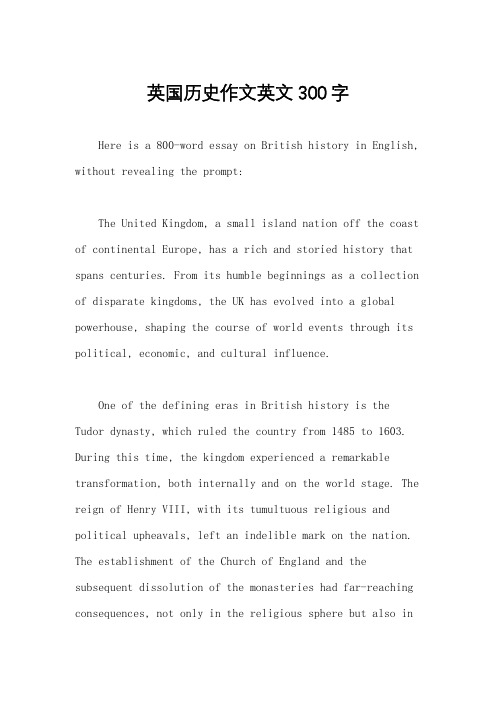
英国历史作文英文300字Here is a 800-word essay on British history in English, without revealing the prompt:The United Kingdom, a small island nation off the coast of continental Europe, has a rich and storied history that spans centuries. From its humble beginnings as a collection of disparate kingdoms, the UK has evolved into a global powerhouse, shaping the course of world events through its political, economic, and cultural influence.One of the defining eras in British history is the Tudor dynasty, which ruled the country from 1485 to 1603. During this time, the kingdom experienced a remarkable transformation, both internally and on the world stage. The reign of Henry VIII, with its tumultuous religious and political upheavals, left an indelible mark on the nation. The establishment of the Church of England and the subsequent dissolution of the monasteries had far-reaching consequences, not only in the religious sphere but also inthe social and economic realms.The Elizabethan era that followed, under the rule of Queen Elizabeth I, witnessed a flourishing of the arts, literature, and exploration. The defeat of the Spanish Armada in 1588 cemented Britain's status as a maritime power, paving the way for its eventual rise as a global empire. The works of William Shakespeare, arguably the most renowned playwright in the English language, continue to captivate audiences worldwide and serve as a testament to the cultural richness of this period.The 17th century brought with it the English Civil War, a conflict that would ultimately lead to the execution of King Charles I and the establishment of the Commonwealth of England under Oliver Cromwell. This turbulent period was followed by the Restoration of the monarchy under King Charles II, which ushered in a new era of political and social stability.The 18th and 19th centuries saw the rise of the British Empire, which at its peak spanned the globe, encompassing aquarter of the world's population and a third of its landmass. This expansionist era was marked by both remarkable achievements and controversial colonial policies, leaving a complex legacy that continues to be debated and analyzed by historians.The 20th century brought about significant challengesfor the United Kingdom, including the two World Wars, the decline of its imperial power, and the emergence of new global superpowers. Despite these trials, the UK has remained a influential player on the international stage, maintaining its position as a leading economic andpolitical force.Today, the United Kingdom stands as a vibrant, multicultural nation, grappling with the complexities of modern-day issues such as Brexit, devolution, and the ongoing process of social and cultural change. Its history, however, remains a source of national pride and a testament to the resilience and adaptability of the British people.In conclusion, the history of the United Kingdom is arich tapestry woven with threads of triumph and adversity, innovation and tradition. From the Tudor monarchs to the industrial revolution, from the heights of empire to the challenges of the modern era, the story of Britain is one that continues to captivate and inspire people around the world.。
英国历史:一部侵略史 英文
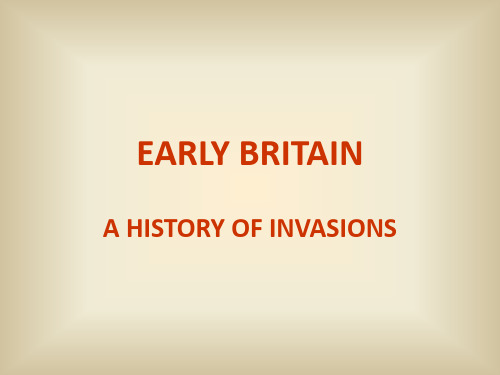
EARLY BRITAIN A HISTORY OF INVASIONSSummary1.The Celts2.The Romans3.The Anglo-Saxons4.The Normans700/600 B.C. Celts appear in BritainStonehengeDruids worshipped the Sun and Moon atStonehengeCeltic traditionCeltic HouseCeltic crossThe Romans •In 55-54 Julius Caesarreaches Britain•In 43 EmperorClaudius invadesBritain andaccomplishes theconquestHadrian’s WallThe Roman advance washalted south of what isnow the border betweenEngland and Scotland.The Scottish refused to becolonized and EmperorHadrian built a wall tokeep raiders out of RomanBritainHADRIAN'S WALL is the most important monument built by the Romans in Britain. It is the best known frontier in the entire Roman Empire and stands as a reminder of past glories of one of the world's greatest civilisations. Designated a World Heritage Site in 1987, Hadrian's Wall ranks alongside the Taj Mahal and other treasures of the great wonders of the world.Spanning nearly 2,000 years of history, dramatic and wild landscapes, towns and cities, a visit to Hadrian's Wall is a must for anyone living in or visiting the North of England. Forts, museums and events bring Roman history to life, walks lead you through spectacular countryside. Time spent exploring this unique Roman heritage in its ever changing setting will leave you with an unparalleled sense of awe and wonder.NEW*Win A Break on Hadrian's Wall: rules for entrants to our "Walker's Guide" competition.or other enquiries, please contact us at info@"It is the land of far horizons, where the piled or drifted shapes of gathered vapour are for ever moving along the farthest ridge of hills, like the procession of long primeval ages that is written in tribal mounds and Roman camps and Border towers on the breast of Northumberland."GM Trevelyan410 the Romans leaveBritainJutes, Anglesand Saxonsinvade BritainThe anglo-Saxonkingdoms The Anglo-Saxons established 7 Kingdoms in Britain: NorthumbriaMercia✓East Anglia✓Essex✓Kent✓SussexWessexKing ArthurHe leds the CelticBritons in theirresistance againstthe Saxon invadersAlfred the Great •He was the greatestAnglo-Saxon king andcame from Wessex.•He translated latinworks in Anglo-Saxonlanguage.1066 The Normans invade Britain。
英国历史简介

• 推荐影片:《凯撒大帝》(Julius Caesar) 《埃及艳后的任务》
盎格鲁-撒克逊时期
• 罗马人撤走后,欧洲北部的盎格鲁人、萨 克逊人、朱特人相继入侵并定居。7世纪开 始形成封建制度,许多小国并成七个王国, 争雄达200年之久,史称“盎格鲁—撒克逊 时代”。
• 盎格鲁-撒克逊人
现在大部分英国人就是盎格鲁-撒克逊人。 盎格鲁·撒克逊人属于日耳曼民族,他们来自三个不同部落:
盎格鲁人(Angles),萨克逊人和朱特人。)。“英格
兰”(England)来源于Englaland,意即盎格鲁人的土地。 7个王国中以威撒克斯为最强,国王爱格伯特(802—839 年)于829年初步统一英格兰。
4
5
The Warrior of Vikings
6
7
The Vikings’ Castle
8
• King Alfred the Great (r. 871-899) p18
King Alfred of Wessex, a talented statesman and soldier and the greatest figure in the history of Anglo-Saxon England, succeeded in pushing the Danes back. Alfred is often regarded as the first king of a united England. P84, 93, 97
它来源于两个皇族所选的家徽,兰开斯特 的红玫瑰和约克的白玫瑰。
• 主要人物
•
英格兰国王
•
亨利六世(Henry VI of England)(兰开斯特家族)
英国介绍英文版作文

英国介绍英文版作文英文回答:Introduction to the United Kingdom。
The United Kingdom, also known as Britain, is a sovereign island nation located in northwestern Europe. It comprises England, Wales, Scotland, and Northern Ireland. The UK has a rich history, a vibrant culture, and a global influence.Geography and Climate。
The UK is bordered by the North Sea to the east, the English Channel to the south, and the Celtic Sea to the west. The country has a diverse landscape, including rolling hills, mountains, and coastline. The climate is temperate, with mild winters and warm summers.History。
The history of the UK dates back thousands of years, with evidence of human habitation from prehistoric times. The Romans invaded the region in the 1st century AD, and the country was later ruled by various groups, including the Saxons, Vikings, and Normans. The United Kingdom of Great Britain and Ireland was formed in 1801, and the Republic of Ireland seceded in 1922.Politics and Government。
英国历史英文 ppt课件

Colonial Expansion 殖 民扩张
1、Began with the colonization of Newfoundland in 1583.
2、By 1900,Britain had built up a big empire, “on which the sun never set”
Roman Britain
罗马统治下的英国(公元前55年—410年)
1、In 55BC and 54BC, Julius Caesar, a Roman general, invaded Britain twice. In AD 43, the Emperor Claudius invaded Britain successfully. For nearly 400 years, Britain was under the Roman occupation, though it was never a total occupation.
3、It saw the challenge of supremacy of the Roman Catholic Church by Reformation , the rise of Humanism ,the growth of large nation-states ,the farranging voyages of exploration and a new emphasis o the importance of individual.
1、In 1833,the Grand National Consolidated Trade
abriefhistoryofBritain英国历史简述(精选五篇)

abriefhistoryofBritain英国历史简述(精选五篇)第一篇:a brief history of Britain 英国历史简述A Brief History of Britainby Pam BarrettWhen French and British construction workers met beneath the English Channel in 1990, Britain became linked to Continental Europe for the first time in 7,000 years.For it was then, when the last Ice Age ended, that melting ice flooded the low-lying lands, creating the English Channel and the North Sea and turning Britain into an island.This fact of being “set apart” was one of the two seemingly contradictory factors which would affect every aspect of the country’s subsequent history.The other was a genius for absorbing every invader and immigrant, creating a mongrel breed whose energies would establish an empire incorporating a quarter of the population of the planet.Early settlers: Stone Age people arrived, probably from the Iberian peninsula, in around 3000 BC.They lived by farming but left few traces.The most dramatic ancient monument is Stonehenge in Wiltshire, built during the next 1,000 years.How and why it was built was a mystery, but it must have had religious and political significance.The Beaker people, named after their pottery, were next to arrive.But a more importance wave of immigration, in 700 BC, was that of the Celts from eastern and central Europe.The ancestors of the Highland Scots, the Welsh and the Irish, they left behind a rich legacy of intricate and beautiful metalwork.The Romans: British recorded history began when Julius Caesar first crossed the English Channel in 55 BC.Roman rule continued for nearly 400 years, failing to subjugate only Scottish tribes, whose raiding parties were contained by Emperor Hadrian who built adefended wall right across the north of England.Eventually, threatened by barbarians at the gates of Rome, they abandoned Britain, leaving behind them a network of towns, mostly walled, a superb road system, and a new religion, Christianity.The next wave of invaders from central Europe – Angles, Saxons and Jutes – gradually pushed the native Celts west into Wales and north into Scotland.Anglo-Saxon dominance, too, lasted for four centuries, though it did not extend to Scotland, where a separate kingdom was forged by the Picts and the Scots.Although the Anglo-Saxons were a ferocious bunch, constantly squabbling, they laid the foundations of the English state, dividing the country into shires and devising an effective farming system.Their Teutonic religion, worshipping gods such as Woden and Thor, eclipsed Christianity until, at the end of the 6th century, the monk Augustine(once heard to remark “O Lord, make me chaste, but not yet”)converted the kings and the nobles.Monasteries sprang up, becoming places of learning.Treasures contained in the monasteries were a lure for the Vikings, whose ruthless raids from across the North Sea began in the 9th century.Initially they were defeated at sea by Alfred the Great, founder of the British Navy, but eventually they too were assimilated.Canute, the Danish leader, became king of Britain.The Norman Conquest: Links with Normandy, the part of France settled by the Vikings, were strong, and in 1066 William, Duke of Normandy, claimed the English throne.His triumph at the battle of Hastings decisively changed English history.As W.C.Sellar and R.J.Yeatman put it in their classic humorous history 1066 And All That: “The Norman Conquest was a Good Thing, as from this time onwards England stopped being conquered and thus was able to become top nation.”William parceled out the land to barons in return for their loyalty, and the barons parceled out land in turn to lesser nobles in return for goods and services.At the bottom were the peasants, whose feudal status resembled slavery – hence the potency of the Robin Hood legend, celebrating the Nottingham outlaw who stole from the rich to give to the poor.Although much of the Norman kings’ energies were devoted to protecting their borders, there was a great flowering of Norman culture, producing many erudite historians and scholars.In 1167 Oxford University was founded.Thanks to the influence of William Shakespeare’s history plays, much of the next period of English history is popularly remembered through his view of the shifting alliances of the Plantagenet and Tudor kings who ruled from 1154 to 1547.During this period of conflict and disease –the Black Death alone killed nearly half the population in 1348-49 –the royal succession was by no means assured.Power struggles propelled to the throne those who could command the greatest military backing from the majority of the rival barons, a process vividly illustrated by the Wars of Roses, the tussles between the House of Lancaster and York between 1455 and 1485.Frequent strife with France(including the intermittent Hundred Years’ War from 1337 to 1453)dominated international relationships.Internally, Wales was subjugated by 1288, though Scottish independence was recognized when Robert Bruce defeated English forces at the Battle of Bannockburn in 1314.Britain’s most famous king, Henry VIII, is remembered not only for his six wives(two of whom he had beheaded)but also for bringing about the Reformation, making England a Protestant rather than a Catholic countr y.His quarrel centred on the Pope’s refusal to annul his marriage to Catherine of Aragon, who couldnot oblige him with a male heir.Doctrinal differences aside, however, Henry capitalized on a growing distaste for the church’s excessive privilege and wealt h, and was thus able to get away with seizing enough monastic lands and property to finance his rule.Under Henry, Wales was formally united with England in 1536.The Age of Elizabeth: England entered its Golden Age under Elizabeth I, Henry’s daughter by Ann e Boleyn.The Elizabethan Age has a swashbuckling ring to it: the Virgin Queen and her dashing courtiers;the defeat of the Spanish Armada;Sir Walter Raleigh’s discovery of tobacco in Virginia;Sir Francis Drake’s circumnavigation of the world.Poetry, plays a nd pageantry flourished during her 45-year reign.When Elizabeth, the “Virgin Queen”, died without an heir, the throne passed to James VI of Scotland, who became James I of England, inaugurating the Stuart dynasty and effectively joining together the two kingdoms.The Stuart period was one of conflict between Crown and Parliament.James I, a staunch believer in the Divine Right of Kings, would have preferred no Parliament at all, and Charles I dissolved Parliament and initiated an 11-year period of absolute rule.The upshot was a civil war from 1622 to 1649;Charles lost and was beheaded.A period of republicanism followed, under the rule of Oliver Cromwell, but after his death the monarchy was restored and prospered under Charles II.His brother, who succeeded him as James II, was less circumspect and tried to restore absolute monarchy and the Catholic religion.The newly emerging political parties, growing in confidence, forced him to flee and invited his daughter Mary and her Dutch husband, Prince William of Orang e, to take the throne.This “Glorious Revolution”, although bloodless, was nonetheless a revolution and paved the way for Parliament’s permanent dominance overthe Crown.In 1707 an Act of Union united England and Scotland, although Scotland was allowed to retain its own Church and legislature.Many Scots felt that the union was bulldozed through by English politicians’ intent on improving their international trade prospects, and Scottish pressure to unravel the union is still a political issue.Political pragmatism triumphed again in 1714 when, a reliable Protestant monarch being needed in a hurry, a search through the family tree came up with George I of Hanover in Germany.Although he spoke no English and had little interest in his subjects, he founded a dynasty which was to span 115 years and encompass an expanding empire and an industrial revolution.The age of empire: Despite the loss of its American colonies in 1783, Britain’s trade-driven adventurism was undiminished, giving it control of West Africa and India, Newfoundland and Nova Scotia, some Caribbean island, and Australia and New Zealand.At home, farmers embraced more efficient and profitable methods, which led to the eviction of many peasant farmers who either emigrated to the New World, carrying with them a resentment that would bequeathed to future generations, or left the land to find work in the towns, which rapidly became overcrowded.This combination of landowners with surplus capital to invest and laborers in search of a living was one reason why British became the first country to industrialize.Political stability helped too, as did the security of being an island, natural resources, good trade arrangements and a native genius for inventing things.The Scottish inventor James Watt modified and improved the steam engine in the 1770s, opening the way for the efficient powering of trains, ships and factory machinery.The invention of the Spinning Jenny and the power loom created mass production in textiles.The smelting ofiron with coke, instead of charcoal, hugely increased the production of iron.A massive building program of railways, roads and canals created a new class of industrialist, whose fortunes rivaled those of the aristocracy.But it also created abominable working conditions in mines and factories, conditions which led to the slow and painful development of trade unionism.Political reforms, seized elsewhere in Europe by revolution, came gradually in Britain.Parliamentary seats were distributed more fairly among the growing new towns, but voting was still based on property ownership and universal suffrage didn’t come until 1918(and even then was scarcely universal since it excluded women under 30).The problem that dominated parliamentary debate during this period was the intractable Irish Question.The resentment over centuries of British rule in Ireland bubbled to the surface after the potato famines of the mid-1840s, when about 20 percent of Ireland’s population died of starvation and more than a million people emigrated to escape a similar fate.Demands for Irish independence grew but they were demands which many English politicians, conscious of the security problems of having an independent and possibly none-too-friendly neighbor to their west, were reluctant to grant.As with today’s IRA campai gn, the debate had a backdrop of violence.T oday, however, the Victorian Age is remembered as a time of exuberant self-confidence, symbolized by the building in London of the Crystal Palace to showcase Britain’s industrial and technical achievements in the Great Exhibition of 1851.But many of London’s inhabitants might well have wondered when they would benefit from all these accomplishments.For them, the squalor and crime which Charles Dickens portrayed so evocatively in his novels were all too real.Working-class lifeimproved considerably during the last quarter of the 19th century.Many homes had gas lighting and streets were cleaned by the new municipal councils.A new police force contained crime.The music hall provided inexpensive entertainment in towns.Bicycles became a common method of transport, and a trip by train to seaside resorts was for many a highlight of summer.In London, trains in the world’s first underground railway began puffing their way through smoke-filled tunnels between Paddington and Farrington in 1863.Art and drama flourished.By the time of Queen Victoria’s Diamond Jubilee in 1897, the country was feeling quite pleased with itself.Britannia ruled the waves, and anything seemed possible.The 20th century: But all good things come to an end.The Boer War of 1900 ended in victory for the British in South Africa but damaged its international reputation.France, Germany and America were becoming powerful competitors for world markets.The newly united German state was flexing its military muscles.The Edwardian era of the early 20th century, seemingly an idyllic time, was built on shifting sands.Dragged into World War I by a complex web of international alliances, Britain faced unimaginable carnage in which more than a million of its young men died.Social unrest at the end of the war, though less devastating than in the defeated Germany, gave more power to women(who had shouldered a heavy burden while the men were at war)and led to a General Strike by dissatisfied workers in 1926.The Irish Question was partly answered with the creation of an independent Irish free State, but six Protestant-dominated counties in the north stayed under UK rule – a time bomb which exploded in 1969.The shock waves from the 1929 New York Stock Market crash plunged Britain into depression, throwing millionsout of work, especially in the industrial areas of northern England, south Wales and Clydeside in Scotland.The monarchy was rocked by crisis in 1936 when Edward VIII, who had just become king, decided to marry the twice-divorced Mrs Wallis Simpson.His family, the church and the government opposed the match, forcing him to abdicate.His brother, a reluctant George VI, restored the monarchy’s popularity, not least through the support which he and his wife Elizabeth(later the Queen Mother)gave to their subjects during the German air raids of World War II.Although Britain’s island status saved it from invasion, this war involved civilians in an unprecedented way.Cities like Coventry were devastated by bombing and the Blitz radically changed the face of London for the first time since the Great Fire of 1666.Many children were sent to live in the countryside.Most social inequalities were set aside during the war and, when peace returned in 1945, voters turned to the Labour party in hope that it could develop an even greater egalitarianism.It laid the basis of a welfare state, providing free medical care for everyone as well as financial help for the old, the sick and the unemployed.But the war had left Britain broke.While Germany and Japan rebuilt their industries almost from scratch, helped by international aid, Britain was left to patch together a severely damaged economy.It could no longer sustain an empire, and gradually its colonies became independent.Many former subjects, especially from the Caribbean and the Indian sub-continent, settled in Britain, raising fears of racial conflict that, despite some serious tensions, were never(quite)fulfilled.As the austere 1950s gave way to the ’60s, things started to look up.New universities were built, a motorway network launched, and a reinvigorated culture promoted by a group of writersdubbed “the angry young men”.Much of the explosion of new talent came from the north of England: actors like Albert Finney, playwrights like Alan Sillitoe, and pop groups galore, led by the Beatles.The swinging Sixties, powered by a newly affluent youth, had arrived.Britain’s heavy industry might be in trouble, but in fashion and pop music it led the world.The good times died in the 1970s as inflation and unemployment soared and labour unrest led to endless strikes.Joining the European Community in 1973 seemed to produce few obvious economic benefits and revenues from North Sea oil were quickly spent rather than invested.Margaret Thatcher came to power in 1979 promising tough new policies.Her popularity quickly faded, but was revived in 1982 by the Falklands War when an invading Argentinean force was beaten off the South Atlantic islands, remnants of the old empire.Although she went on to win two further elections convincingly, by 1990 her popularity, always firmer abroad than at home, was so shaky that her party, fearing that she would not win them the next election, replaced her with a less combative leader, John Major.He duly won the 1992 election, but a reinvigorated Labour Party under T ony Blair won in 1997.The overall problems did not change, though.The economy remained weak, distrust of the European Community did not abate, nationalism simmered in Wales and Scotland, the conflict in Northern Ireland dra gged on, and the Royal Family’s private life continued to obsess the tabloid press.It was business as usual, in fact – which, in a country obsessed by continuity, was immensely reassuring.第二篇:材料学的历史简述姓名:何莞晨学号:2014012075材料学的历史简述1.按材料划分的时代生活离不开材料,人类的一切生产活动所需的工具都建立在合适的材料的基础上。
英国国家概况(二)(中英文版)

英国国家概况(二)(中英文版)第二章The Origins of a Nation (5000BC-1066)英国的起源(公元前5000年-1066年)I.Early Settlers (5000BC-55BC)早期的居民(公元前5000年-公元前55年)1.The first known settlers of Britain were the Iberians.人们所知的英国最早居民是伊比利来人。
2. At about 2000 BC the Beaker Folk arrived from the areas now know as Holland and Rhineland.约公元前2000年,从现在的荷兰和莱茵兰地区来了宽口陶器人。
3. The Celts began to arrive Britain about 700 BC.约公元前700年,克尔特人来到不列颠岛。
4. The Celts came to Britain in three main waves.克尔特人来到不列颠有三次高潮。
The first wave were the Gaels-came about 600 BC.第一次高潮是约公元前600年盖尔人的来临。
The second wave were the Brythons-came about 400 BC.第二次高潮是约公元前400年布立吞(不列颠)人的抵达。
The third wave were the Belgae-came about 150 BC.第三次是约公元前150年比利其人的到达。
II. Roman Britain (55BC-410AD)罗马人统治时期的英国(公元前55年-410年)1.British recorded history begins with the Roman invasion. In 55BC and 54BC, Julius Caesar, a Roman general, invaded Britain twice. In AD 43, the Emperor Claudius invaded Britain successfully. For nearly 400 years, Britain was under the Roman occupation, though it was never a total occupation.有记录的英国历史开始于罗马人的入侵。
初中历史英国史整理

初中历史英国史整理**History of England in Junior High School**The history of England is rich and diverse, spanning from ancient times to the present day.英国历史丰富多彩,从古代一直延续至今。
In the early period, England was populated by Celtic tribes.早期,英格兰被凯尔特部落占据。
The Roman Empire later invaded and occupied England, leaving behind a lasting impact on its culture and architecture.后来罗马帝国入侵并占领了英格兰,对其文化和建筑产生了深远的影响。
The Norman Conquest in the 11th century marked a significant turning point, introducing feudalism and the Norman language to England. 11世纪的诺曼征服是英格兰历史上的重要转折点,它引入了封建制度和诺曼语言。
The Tudor dynasty in the 16th century saw significant religious reforms, most notably the establishment of the Church of England. 16世纪的都铎王朝见证了重大的宗教改革,最显著的是英格兰国教的建立。
The Industrial Revolution in the 18th and 19th centuries transformed England into a leading industrial power, shaping its economic and social landscape.18世纪和19世纪的工业革命使英格兰成为领先的工业强国,塑造了其经济和社会面貌。
